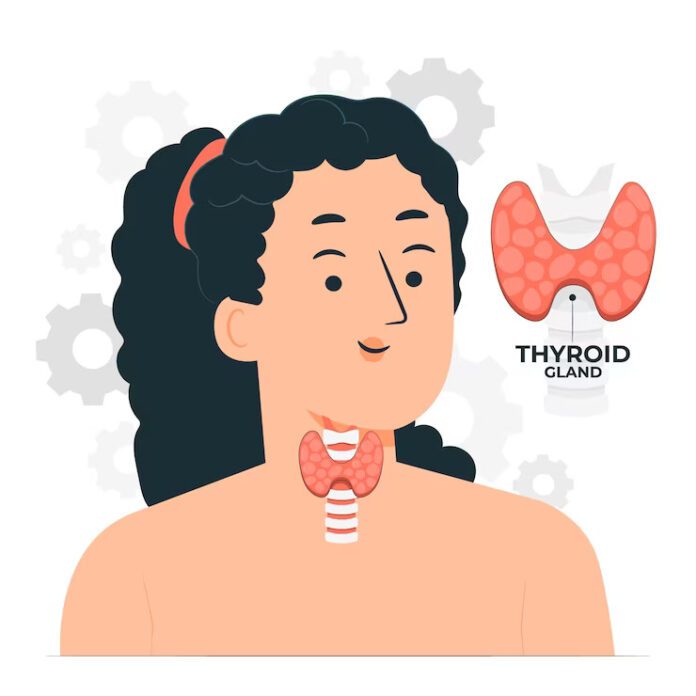Introduction
Thyromegaly, commonly referred to as an enlarged thyroid gland, is a medical condition that affects a significant portion of the population. While it might sound intimidating, understanding thyromegaly, its causes, diagnosis, and management strategies are crucial for maintaining good health.
1: What is Thyromegaly?
Before delving into the causes, diagnosis, and management of thyromegaly, let’s start with the basics. What exactly is thyromegaly?
1.1. Understanding Thyromegaly
Thyromegaly is a medical term used to describe the abnormal enlargement of the thyroid gland, which is located at the base of your neck. This gland regulates various bodily functions, including metabolism and energy production. When it enlarges beyond its standard size, it can lead to multiple health issues.

2: Causes of Thyromegaly
Thyromegaly doesn’t occur without reason. Several factors can contribute to the enlargement of the thyroid gland, and understanding these causes is essential for effective management.
2.1. Iodine Deficiency
One of the leading causes of thyromegaly worldwide is iodine deficiency. Iodine is a crucial nutrient that the thyroid gland requires to produce hormones. Without sufficient iodine, the thyroid can enlarge as it tries to compensate for the deficiency.
2.2. Autoimmune Disorders
Autoimmune disorders, such as Hashimoto’s thyroiditis and Graves’ disease, can also lead to thyromegaly. In these conditions, the immune system mistakenly attacks the thyroid gland, causing inflammation and enlargement.
2.3. Nodules and Goiters
Thyroid nodules and goiters, non-cancerous growths, can cause localized thyromegaly. These growths can develop for various reasons, including genetics and exposure to radiation.
2.4. Medications
Certain medications, such as lithium, can trigger thyroid enlargement as a side effect. It’s essential to discuss potential medication-induced thyromegaly with your healthcare provider.
3: Diagnosing Thyromegaly
Early diagnosis of thyromegaly is crucial for effective treatment. Here’s how healthcare professionals go about diagnosing this condition.
3.1. Physical Examination
Your healthcare provider will typically begin with a physical examination, during which they will feel your neck for any swelling or abnormalities in the thyroid gland.
3.2. Blood Tests
Blood tests can help measure thyroid hormone levels and detect any abnormalities. High or low levels of specific hormones can provide clues about the cause of thyromegaly.
3.3. Imaging Tests
Imaging tests, such as ultrasound, CT scans, or MRI, can provide detailed images of the thyroid gland’s size and structure. This helps in identifying nodules or goiters.
3.4. Fine-Needle Aspiration (FNA) Biopsy
In cases where nodules or suspicious growths are detected, an FNA biopsy may be performed. A small tissue sample is extracted for further examination to rule out cancer.
4: Managing Thyromegaly
Once thyromegaly is diagnosed, the next step is determining the appropriate management strategy. Depending on the origin and seriousness of the illness, several treatments are available.
4.1. Lifestyle Modifications
Lifestyle modifications can be highly effective for mild cases of thyromegaly, especially those related to iodine deficiency. Increasing your iodine intake through diet or supplements may help normalize thyroid function.
4.2. Medications
In cases of autoimmune-related thyromegaly, medications to regulate the immune system or thyroid hormones may be prescribed. These medications can help manage symptoms and slow down the enlargement of the thyroid gland.
4.3. Radioactive Iodine Therapy
Radioactive iodine therapy is commonly used for individuals with an overactive thyroid (Graves’ disease). It helps reduce thyroid activity and may shrink an enlarged thyroid gland.
4.4. Surgery
Surgical removal of all or part of the thyroid gland may be necessary in severe cases or when cancer is suspected. This procedure is called a thyroidectomy.
4.5. Ongoing Monitoring
Regardless of the chosen treatment, ongoing monitoring of thyroid function is essential. Regular check-ups with your healthcare provider ensure that your treatment remains effective and that any changes in your condition are promptly addressed.
5: Living with Thyromegaly
Managing thyromegaly is not just about medical treatments; it also involves making lifestyle adjustments to promote overall well-being.
5.1. Healthy Diet
A well-balanced diet rich in iodine, selenium, and other essential nutrients can support thyroid health. For individualized nutritional advice, speak with a qualified nutritionist.
5.2. Stress Management
Chronic stress can negatively impact thyroid function. Implement stress-reduction techniques such as yoga, meditation, or deep breathing exercises into your daily routine.
5.3. Medication Adherence
You must take any prescription drugs exactly as your doctor has instructed. Skipping doses or discontinuing treatment without guidance can lead to complications.
5.4. Regular Follow-ups
Make sure to attend your follow-up appointments. Regular monitoring ensures that any changes in your thyroid health are promptly addressed.
Conclusion
In conclusion, thyromegaly is a medical condition that can significantly impact your health if left untreated. Understanding its causes, diagnosis, and management strategies is essential for anyone affected by or concerned about this condition. Whether dealing with thyromegaly or supporting a loved one, knowledge is your best ally in managing this condition effectively and leading a healthy, fulfilling life. Stay informed, seek medical guidance, and make lifestyle adjustments to optimize your thyroid health.
Frequently Asked Questions (FAQs)
1: What are the common symptoms of thyromegaly?
Common symptoms of thyromegaly may include neck swelling, difficulty swallowing, hoarseness, fatigue, and changes in weight or appetite.
2: Is thyromegaly the same as thyroid cancer?
No, thyromegaly refers to an enlarged thyroid gland, which can have various causes, including non-cancerous ones. Thyroid cancer is a separate condition where malignant cells develop in the thyroid gland.
3: Can I prevent thyromegaly?
While you can’t always prevent thyromegaly, you can reduce your risk by ensuring an adequate intake of iodine through your diet or supplements and managing underlying conditions that may contribute to thyroid enlargement.
4: How is thyromegaly treated?
The treatment for thyromegaly depends on its underlying cause and severity. Treatment options may include lifestyle modifications, medications, radioactive iodine therapy, or surgery.
5: Are there any dietary recommendations for managing thyromegaly?
A balanced diet with foods rich in iodine, selenium, and other essential nutrients can support thyroid health. For individualized nutritional recommendations, speak with a medical professional or certified dietitian.
6: Is thyromegaly a life-threatening condition?
In most cases, thyromegaly is not life-threatening, especially when promptly diagnosed and managed. However, severe or cancer-related cases may require more aggressive treatment.
7: Can I live an everyday life with thyromegaly?
With proper management and ongoing medical care, individuals with thyromegaly can lead everyday, healthy lives. Following your healthcare provider’s recommendations and attending regular check-ups is essential.
8: How often should I have my thyroid checked if I have thyromegaly?
The frequency of thyroid check-ups will depend on the severity of your condition and your healthcare provider’s recommendations. Typically, individuals with thyromegaly should have regular follow-up appointments to monitor their thyroid function.
These frequently asked questions should provide readers with quick and informative answers to common concerns about thyromegaly.

